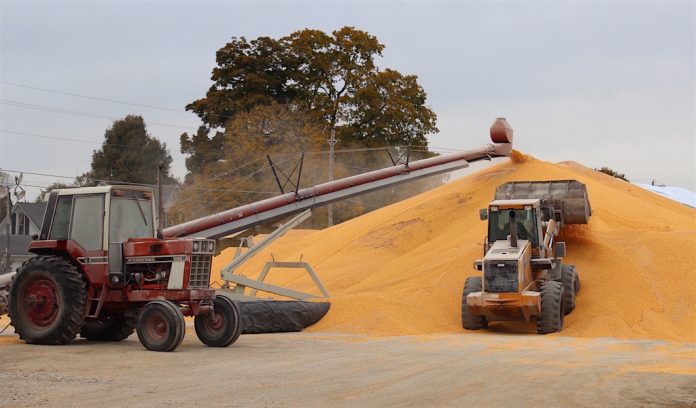SALEM, Ohio — As harvest season continues, many farmers are finding themselves short on storage space. The price is lower than they would like, but corn yields are pushing 200 bushels per acre in many places, and some farmers and farm elevators just don’t have enough storage.
To help compensate, they’re turning to machinery storage buildings, warehouses, livestock buildings or even parking lots. While all of these can be viable options, there are many factors to consider when storing grain outside of the traditional grain bin.
• • •
1 Know your capacity. When deciding whether to use an existing building or structure to store grain, do some basic measurements to determine how much you can safely store, and whether it will be worth your effort in the end. Also consider whether you’ll be able to access the building to dump additional grain, how you’ll access the building to aerate and the dry the grain, and how much space you’ll need to remove the grain after harvest.
2 Sanitation and preparation. Obviously, certain structures will require more cleaning and preparation than your standard grain bin. Be sure to remove all previous grain, stones and foreign matter, and sanitize the structure if there’s a concern with insects or disease. You also need to think about exposure to birds and rodents, and the damage such critters can do. Keep the building as dry as possible, and consider adding a cover, if long-term storage is necessary.

3 Is the building structurally sound? According to Purdue University, dry grain exerts a pressure on sidewalls of about 23 pounds per foot of grain depth, so consider whether the walls of your building are strong enough to hold the amount of grain you plan to add. You can reinforce the walls by adding cables or self-supporting interior walls, or you can set up a storage area with free-standing boulders, preventing the grain from touching the sidewalls. Considering these factors will not only protect your building from damage, but could also prevent a serious accident to a farm worker or children.
4 Watch the moisture. When storing grain in bulk, pay close attention to the moisture and provide the appropriate air circulation to prevent molding. Aeration may be necessary if the grain pile generates too much heat, and to help prevent moisture condensation and to control insects. There are various types of equipment that can be purchased or rented to assist with aeration, or with unloading or loading of bulk grain. Airflow rates depend on grain moisture and other factors, but a rate of at least .1 cfm per bushel of grain is suggested.
Learn more. These tips were adopted from reports published by the Pioneer seed company, and Purdue University. According to Pioneer, grain quality does not improve during storage — it only diminishes — and you need to keep a close eye on all aspects, especially when using an alternative storage structure.
Sources available. The Pioneer report, Temporary Storage of Corn Grain, can be accessed at www.pioneer.com/home/site/us/agronomy/library/corn-temporary-storage/.
The Purdue report, Temporary Grain Storage Considerations, is available at www.extension.purdue.edu/extmedia/gq/gqtf38/gqtf-38.html.












